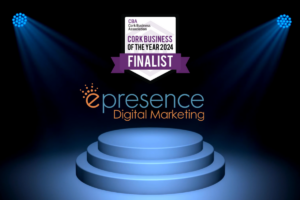Improve your eCommerce Conversion Rates
What is eCommerce Conversion Rate?
Conversion rate is the number of desired actions, and conversions, taken on a website as a percentage of the total number of site visitors.
A conversion may vary for each company and could include receiving a contact enquiry, someone downloading an ebook or an email subscription. Generally in eCommerce, a conversion is defined as a site visitor completing an actual purchase.
Typically conversion rate would be calculated as follows:
Number of Sales / Site Visitors x 100
Example:
If your website has 10 000 visitors in a month and makes 250 sales in that period your conversion rate would be
250 / 10 000 x 100 = 2.5%
Improving your eCommerce Conversion Rate is the most cost-effective way to generate more sales and profit.
What is Conversion Rate Optimisation?
Conversion Rate Optimisation is the art of improving the effectiveness of your overall sales funnel. Basically improving your eCommerce Conversion Rate. Having a professional eCommerce Website developed by experts is a great start to improving your eCommerce Conversion Rates.
How do we improve eCommerce Conversion Rate?
- From targeting and attracting the right people at the top of the funnel during the Awareness stage of the buyer’s Cycle.
- Providing the correct information to these visitors during the Research stage.
- Converting these leads into paying customers at the bottom of the funnel during the Decision Making Process.
Contact Us for a professional eCommerce Web Design
What is considered a good eCommerce conversion rate?
The rapid increase in online shopping has been met with an even more rapid increase in the number of Online Shops to choose from. We have entered a period of abundance where anyone can order just about anything online and have it delivered to their door.
The entry barriers to selling online are quite low compared to a more traditional brick-and-mortar business, hence many companies have moved online, or exist only online. This proliferation of online stores has led to increased competition for customers’ attention.
While it may be getting easier to set up an online store, achieving success online is becoming more difficult, requiring skill, time and money. If a visitor to your online shop does not like what he sees he will quickly move on to your competitor.
Many companies do not divulge their Conversion Rates, but numerous studies place average conversion rates between 1 – 4%. This can vary quite considerably by industry and product with some achieving 10% or higher.
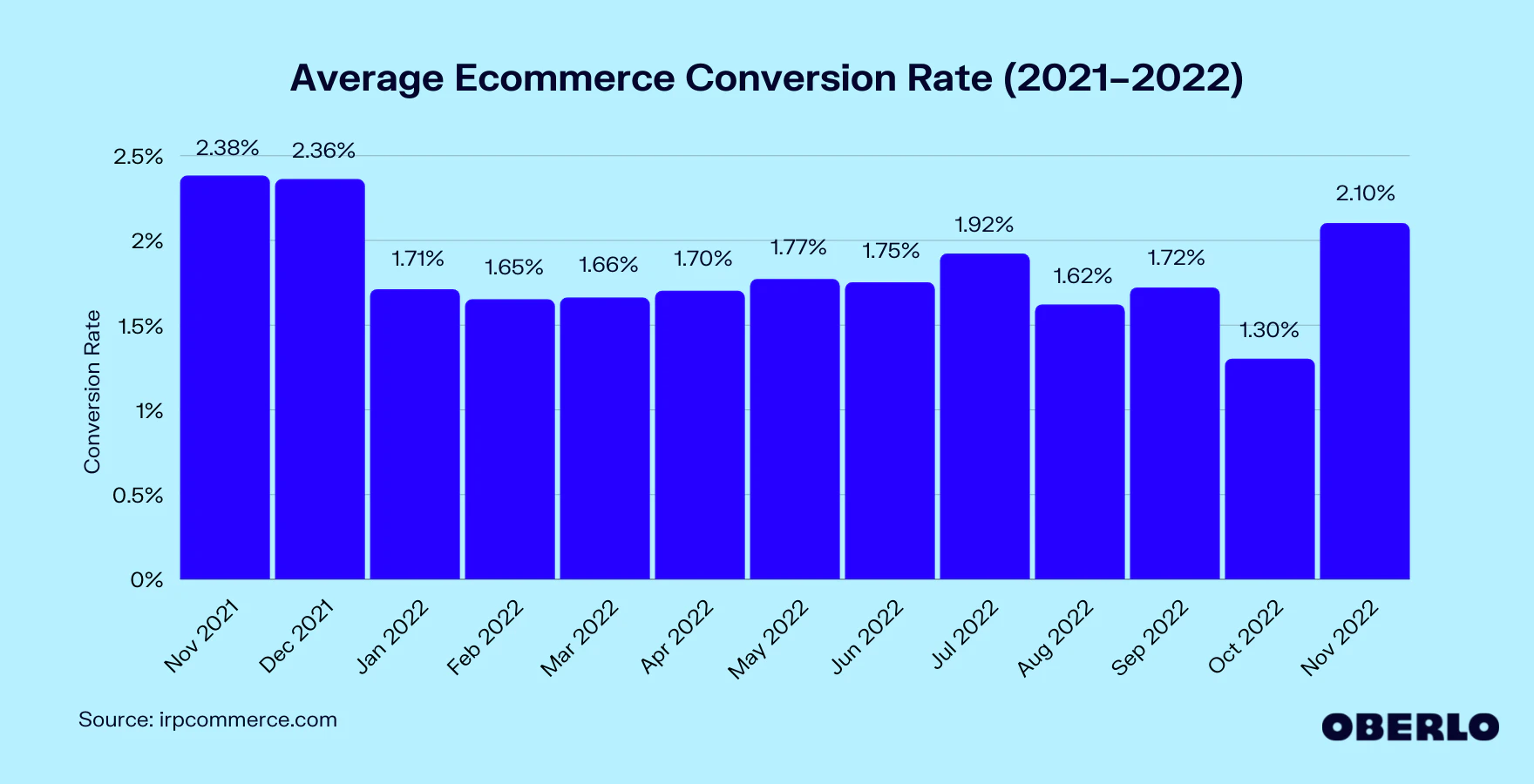
Conversion Rate is Important, but it’s only part of the picture
Conversion Rate is a vital statistic for any eCommerce company as it tells you how effective your overall marketing strategy is and how well your eCommerce website performs. In other words, how good are you at attracting relevant site visitors and converting them into paying customers, let’s take a look at two different fictitious companies in the same industry selling similar products.
Company A has a conversion rate of 1% and Company B has a conversion rate of 5%
Which company would you prefer to own? Don’t decide yet until we take a look at the data in more detail
Company A:
Company A attracts 100 000 monthly visitors to their website, and 1000 of these visitors make a purchase.
1000 / 100 000 x 100 = 1% conversion rate.
Company B:
Company B attracts 2000 monthly website visitors and 100 of these visitors complete a purchase.
100 / 2000 x100 = 5% conversion rate.
While Company B has a high conversion rate of 5% which is 5 times that of Company A. Company A received 1000 orders which are 10 times more than Company B. If conversion rate were the primary goal then Company B would be the clear winner, but if total sales were the goal then Company A would win hands down.
Bear in mind that it is easier to improve conversion rates than it is to attract more relevant website visitors, so company A has greater potential for improvement.
Which company would you rather own now?
Don’t be too obsessed with Conversion Rate as a stand-alone KPI, it is possible that your conversion rate could be improving while overall traffic and sales are dropping and vice versa. It’s vital to monitor a range of statistics and KPIs that give you a good image of your company’s overall health. Statistics taken in isolation, especially percentages, can be misleading.
Contact Us for a professional eCommerce Web Design
The Sales Funnel.
Effective Conversion Rate Optimisation involves making incremental improvements to each step in the sales funnel from attracting more of the right people at the top of the funnel to actual sales at the bottom of the funnel.
By making small incremental improvements to each campaign and step in the funnel we achieve considerable overall improvements in conversions at the bottom of the funnel as these improvements compound each other. (The same way compound interest works)

Source Smart Insights
As with every journey we need to where we are before we can plot the route to where we want to be.
This involves first setting up Google Analytics to track eCommerce events and each step in the process to make it easier to track site visitors through the funnel and pick up where the problems are.
1: At the top of the funnel it’s essential to know how many visitors are being attracted to the site and from:
- What traffic sources such as Organic, Search Ads or Social Media?
- What country or region depends on the geographical area you are targeting.
- What devices are being used?
2: We need to know how many of these visitors are visiting product category pages.
3: We would then look at how many visitors are looking at specific product detail pages.
4: We would look at how many visitors are adding products to their carts.
5: Finally we would look at how many visitors complete an actual purchase.
What does this Sales Funnel data mean?
Tracking these events along the funnel will enable us to calculate drop-offs at each step and identify which areas need to be improved upon.
If we see that 80% of the site visitors are not even looking at product pages then we know immediately that we are not attracting the right people or selling the right products, there may be a problem with site speed or the website is not mobile-friendly and visitors are quickly bouncing off.
If we see that many product pages are being viewed multiple times, but a low percentage are being added to the cart, it could point to a problem with the quality of the description, the product images could be poor quality, our message might lack motivation or the product page might benefit from a re-design.
At the other end of the funnel if we see massive cart abandonment figures above 70% then we know there is a problem at the checkout stage and we need to work on providing alternative payment methods, offering free shipping or just simplifying the checkout process, perhaps adding Cart Abandonment emails to the mix.
Further analysis of the traffic sources through the funnel will give a good indication of where the problem is. It could be a specific campaign that is providing extremely poor results or a high bounce rate on Mobiles.
Monitoring the Conversion Rates of individual products and categories is also important as it can be an indication of possible site-wide issues if all products have low conversion rates as opposed to issues with individual products or categories. Your overall site could have an acceptable 3% conversion rate, but this could be driven by a few very popular products and mask issues with other less popular products that could be improved quite easily.
Once we have identified a problem the best way to fix it is to test it. We advise always running at least some form of simple A/B testing, letting it run for a while and implementing the better-performing page or campaign, then setting up another test to compare against the winning option. Repeat the process of Test – Measure – Implement.
Sources of Traffic.
Not all website visitors are created equally, some website visitors are better quality than others and are more likely to make a purchase, but it’s also important to take the complete sales cycle into account.
Traffic to a website can generally be separated into two sources:
Inbound Traffic
Inbound traffic is visitors that have found your website through some form of search such as performing a search on Google. This traffic is generated through SEO (Search Engine Optimisation) Content Marketing and Google Search Ads.
It is generally true that Inbound Traffic is of better quality because they are already looking for a product or service that you offer and have landed on your website as a result of their search, they are further along the Buyer’s Journey and are more likely to make a purchase.
According to Databox SEO traffic is, on average, the best-converting traffic for eCommerce.
The Inbound traffic sources combined attract 60% of the conversions for eCommerce.
Outbound Traffic.
According to Databox’s data, Inbound Traffic generates 60% of eCommerce conversions which leaves only 40% for other Outbound Marketing techniques, but this figure could be misleading as it does not take direct traffic or referral traffic into account.
As we know a customer requires 7-9 interactions with your Brand before he will actually buy from you. It’s highly unlikely that a potential customer will make a purchase from your online store on their very first interaction with your Brand, especially if you are not a known Brand. This is even more true for more complex big-ticket items where the sales cycle is longer and potential customers perform much more research.
Outbound Marketing creates this much-needed brand awareness and drives interested parties to your online platforms, while these people may not buy from you immediately they may follow you on social media or sign up for your mailing list for further nurturing. At the very least they have “seen” your Brand and this moves them along the Buyer’s Journey making them more likely to buy from you when they are searching for your products or service.
Outbound Marketing may not drive immediate sales or be attributed to online sales the same as Inbound methods, but it is an essential part of the buyer’s process.
Please note – Effective Outbound marketing requires in-depth knowledge of your Buyer’s Persona, getting your targeting or messaging wrong will reduce the effectiveness of your campaigns and result in very low conversion rates.
Contact Us for a professional eCommerce Web Design
Some eCommerce Traffic Advice
It’s important to not only focus on the high conversion traffic sources as other sources may play a positive role in the overall success of your eCommerce campaigns without the data reflecting this. It’s also possible that a particular source could suddenly drop off.
Your SEO traffic could suddenly drop due to a Google algorithm change or a competitor investing more in SEO. The same thing could happen with Search Ads, you may be having great success for a period of time until one or two of your competitors also enters the fray or a new competitor enters the market.
Don’t put all your eggs in one basket.
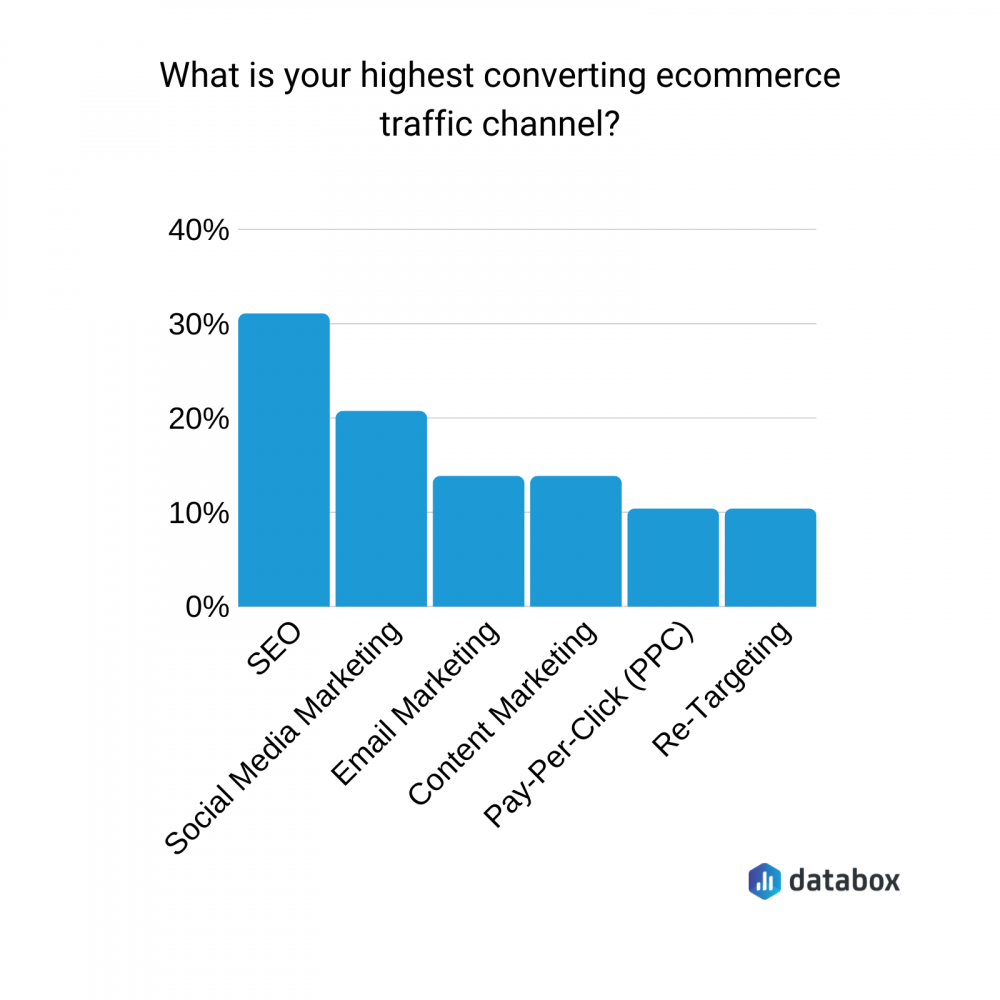
Wolfgang Digital has a useful E-commerce 2019 KPI report based on data from their European and US-based international clients. It’s based on an analysis of over 250 million website sessions and over €500 million in online revenue over the 12 months from July 2017 to June 2018.
eCommerce Website Traffic by Source

Across the various sectors, Inbound methods account for 60% of the traffic, and Direct equates to another 20% which leaves only 20% of traffic being generated by other platforms.
eCommerce Revenue by Traffic Source
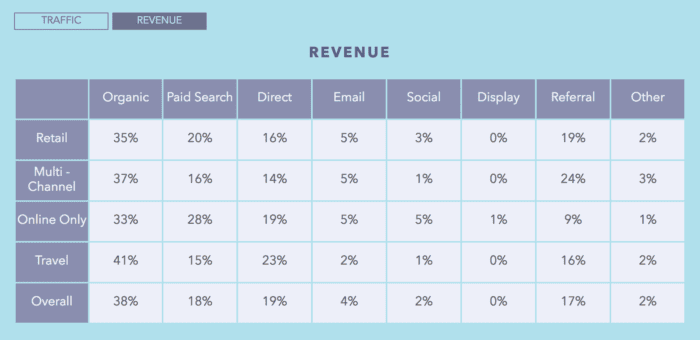
In terms of overall revenue again the Inbound methods of SEO and Paid Search Ads account for the lion’s share 56% of the revenue with Direct methods holding steady at 19% Social and Display ads show that while they are great tools for Brand Awareness few actual sales are directly attributed to these platforms.
Email marketing might not be great for driving massive numbers of site visitors unless you happen to have a massive database but it is highly effective in generating sales at a very low cost providing an excellent ROI.
Referral traffic only generated 7% of the traffic but is responsible for a hefty 17% of revenue, this could be considered a part of SEO and Content Marketing resulting in other websites putting links to your site and driving both traffic and sales, so we could probably add this traffic source to Inbound too.
While the two reports by Databox and Wolfgang Digital are based on different data and provide slightly different figures they do confirm that Inbound Marketing techniques drive the majority of Traffic and Sales in eCommerce.
But as we mentioned earlier Brand Awareness through Banner and Social Media ads is also extremely important in creating awareness of your products or services but might not be given the deserved credit in the attribution of a sale in Analytics.
The below graph provided by Yotpo further illustrates the difference in the quality of the various traffic sources in terms of engagement. Again the Inbound methods work well and surprisingly Instagram ranks highly as an eCommerce source with other Social platforms such as Facebook, Pinterest, Twitter and Reddit lagging at the bottom of the table.
Website Quality Traffic by Source
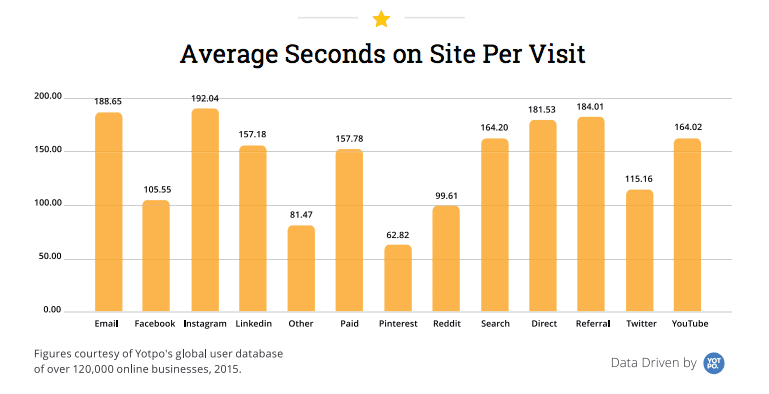
Desktop vs Mobile Conversions
In a recent study by Comscore, it is clear that Mobiles make up not only the majority of eCommerce traffic but also the majority of the time spent on eCommerce websites yet adversely they are only responsible for 20% of the actual spend.
Comscore cites their top five reasons for this, but don’t neglect your mobile visitors as research also suggests that potential customers will perform much of their research on a mobile device but revert to a desktop to make the actual purchase.
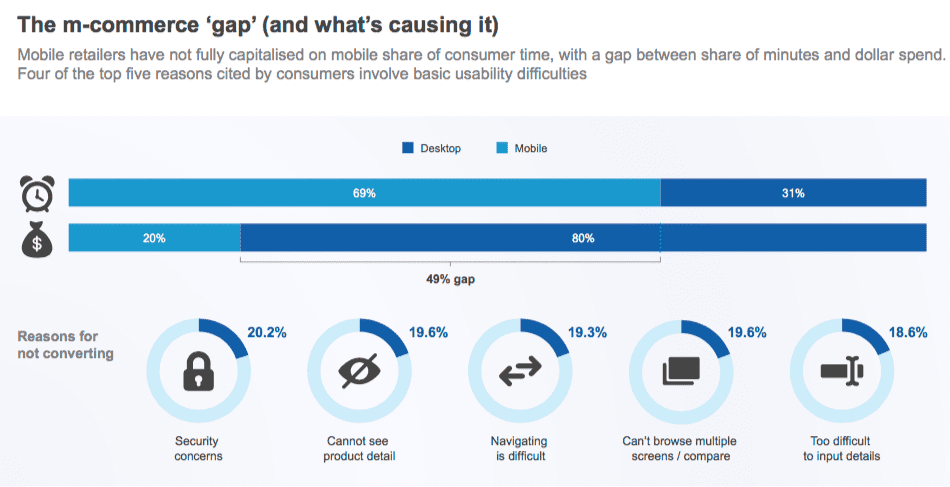
Source – Comscore
Tips to Improve your eCommerce Conversion Rate
1: Make use of high-quality images and videos.
Human beings have five senses and we utilise many of these senses when viewing products in a physical store. We can see the product, we can touch that soft woollen jersey against our skin, we can hear that new sound system, we can smell that new car, we can taste that delicious food.
On a website, we are totally reliant on the images or video to get the potential customer excited so make sure they are top quality and offer a range of images for each product. Low-quality images will create a poor first impression and cheapen the look of your Online Store.
2: Test your checkout procedure well.
You could have the best products in the world, but if your checkout process is poor you are going to struggle to make sales.
- Test your checkout procedure and make sure everything is working well and is simple, offer various payment options such as Credit/Debit Card, Pay Pal and only other systems that may be popular with your customers.
- Please make sure the checkout process is fast, many companies neglect the speed of their checkout pages.
- Ask for the least amount of information required to complete the purchase.
- Don’t forget to allow for Guest checkout, don’t force your customer to create an account.
3: Offer Free Shipping.
If possible offer free shipping, and brag about it. Surprise costs at checkout will result in many carts being abandoned. Be upfront about potential costs if you cannot offer free shipping.
4: Make use of customer testimonials
- Testimonials about your company, products and services are a great tool in encouraging others to also purchase from you.
- Testimonials work best if they appear genuine and from real people, try to get an image and full name if possible.
- Authentic testimonials help overcome the potential objections of others.
5: Social Proof is Imperative.
Product reviews are a powerful tool in encouraging a purchase, if a potential customer sees that other people have bought a product and are happy with it, it increases the belief in that person that they too will be happy with the product. It takes a lot of the “Risk” out of making the purchase.
Install this feature on your eCommerce platform and encourage customers to leave product reviews.
6: Test Pricing and be Competitive.
The digital era has made the ability to compare prices very easy, especially for more expensive items.
Compare your prices with that of your competitors and be competitive, if you are not the cheapest then offer some form of improved value, like free shipping, or some other accessory that goes with the product for free or at a discount.
Offer package deals on related products, enabling customers to create their own packages by allowing them to combine related products together and get a discount based on the value of the package.
7: Personalisation
The younger generation is more likely to deal with a company that provides personalisation in terms of knowing who they are and what they like and providing them with relevant content. More tools are becoming available that allow greater levels of personalisation
8: Make sure your Website is Fast.
Google would love us all to have our page loading time below 2 seconds or faster, unfortunately, this is not always possible. In fact, websites have actually been getting slower in recent years as we demand more powerful features and functions from our platforms all of which require more processing time and power.
It’s a constant trade-off between having all the functions and features we believe we need and having the website perform as fast as possible, but unfortunately, it is true that the slower a website loads the more likely a potential visitor is to simply push the back button on their browser and head off to your nearest competitor.
So it doesn’t matter how many fancy features or functions you have on your website if your customers don’t hang around long enough to see them.
There are numerous tools you can use to check your site speed, GTmetrix, and Pingdom.
Improving the speed of your eCommerce platform may require the assistance of an SEO Specialist.
9: Have a means of reducing Cart Abandonment
It’s not very often you will see someone in a supermarket simply leave their full shopping trolley in the middle of the aisle and walk out of the store, but it happens way too often in an Online Store.
A staggering 70% of Online Shoppers will abandon their cart and leave your store, and many of these shoppers never return to complete the purchase. Some may just have been distracted and simply forget to come back and complete the purchase.
You need to gently remind these people that they have a cart full of goods just waiting to check out. Fortunately, there are numerous plugins and other services available that can help you do this.
10: Offer limited-time or quantity coupons or offers.
Create a sense of urgency with limited-time or quantity offers. Fear of missing out is a powerful motivator – If I don’t buy it now I won’t get it at that price again!
Do you want to read more about Effective eCommerce then check out our Blog on our Top 22 Tips for Effective eCommerce…
Contact Us for a professional eCommerce Web Design






